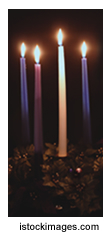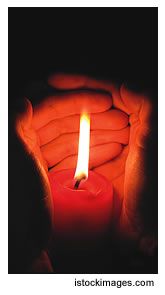Year by year our church calendar, beginning with Advent, provides us with a sacred sequence of observances and celebrations that help us experience the fullness of our faith.
by Dr. Gregory Wismar
Everything seems to be recycled these days—from plastic containers and automobile tires to old newspapers and magazines. Today, we believe the recycling of many things can benefit the environment and our individual lives.
In its own way, the Christian church is involved in recycling, too. Year by year the Church recycles time as the seasons of the Church Year progress in their orderly cycle, a cycle that begins anew each year with Advent.
The Church Year provides us with a sacred sequence of observances and celebrations that assist us in experiencing the fullness of our faith. Every season of the Church Year has a special meaning, distinctive customs, and its own history. The start of this recycling of holy time begins each year on the First Sunday of Advent, a time given for us as Christian people to be spent in remembering, repenting and rejoicing.
Remembering
 Officially, Advent begins on the Sunday closest to the Festival Day of Saint Andrew, Nov. 30. This date for starting the Church Year provides four weeks for the preparation for the coming of Jesus as the Child of Bethlehem on Dec. 25. Although we as Lutherans are quite used to the “four Sundays of Advent,” as well as the four candles on our Advent wreath, our four-week observance is considerably shorter than this special pre-Christmas season has been in times past.
Officially, Advent begins on the Sunday closest to the Festival Day of Saint Andrew, Nov. 30. This date for starting the Church Year provides four weeks for the preparation for the coming of Jesus as the Child of Bethlehem on Dec. 25. Although we as Lutherans are quite used to the “four Sundays of Advent,” as well as the four candles on our Advent wreath, our four-week observance is considerably shorter than this special pre-Christmas season has been in times past.
An early name for this starting time of the Church Year, dating back to France in A.D. 490, was the Latin Quadrigesima Sancti Martini, the Forty Days’ Fast of Saint Martin’s, which began on Nov. 11. Not until the 13th century did the four weeks of Advent, as we know them now, become established throughout the Western Church. Although its length on the calendar varied, Advent was always observed as a sacred time for remembering. The faithful people of God remembered the promise of Christ to return to His people in power and glory, just as He had once come among them in lowliness and humility. The words of the Introit of the Day for the First Sunday in Advent echo the excitement of the prophet Zechariah as he proclaims: “Behold, your King is coming to you; righteous and having salvation.”
Repenting
The coming of the King serves as a sacred invitation for His people to make appropriate preparation for His arrival. Many of the hymns of the Advent season reflect the theme of remembering and of holy preparation. In the classic Advent hymn, “Arise, O Christian People” (LSB 354), we sing: “Prepare my heart, Lord Jesus, Turn not from me aside, and help me to receive You This blessed Advent-tide.” Part of that preparation comes in the form of looking thoughtfully at our lives and repenting of the sins that weigh down our hearts and oppress us and cause us grief in some way.
Just as the length of the Advent season has changed with the passage of time, so also to some extent has the central feeling of the season. In its original usage in some places in Europe, dating back to the first Christian centuries, the season was given over to reflection and penitence. It was a time for repenting of sins and looking to Jesus as the promised Savior who alone could bring forgiveness and the promise of eternal salvation. So strong was that dynamic of Advent in the Frankish Church (the early medieval church of modern-day France and Germany) that the liturgical color for Advent was black, the color reserved for the days of the greatest sorrow: Ash Wednesday and Good Friday. In many churches of medieval France, Advent was a time when weddings were forbidden and organ playing was prohibited so that the focus could remain on the need for God’s salvation that is found in Christ alone.
With the passage of time, that pervasive sense of deep sorrow was moderated, and the color violet, or purple, became the standard liturgical color for the season. Although it kept a hue of reflection and penitence, violet and purple also reflected a sense of royalty and the kingly nature of Jesus. Today, this rich and royal color continues to find use in many Lutheran churches during Advent.
Rejoicing
In recent years, however, another color has found favor in much of the Church. The color of Advent predominantly now is a royal blue, a color that not only reflects the traditionaltheme of royalty, but also is the color associated with hope, capturing in its hue the expanse of the sky from which the Lord Jesus will return. The deep blue also reflects heaven and the endlessness of the eternity promised to all who believe in Him and await His coming with joy and expectation. In the Collect for the First Sunday in Advent, the prayer implores: “Stir up Your power, O Lord, and come, that by your protection we may be rescued from the threatening perils of our sins and saved by your mighty deliverance.” In the season of Advent repenting ultimately becomes rejoicing, as the assurance of the coming of Jesus as Savior and Lord is restated and reaffirmed through the Scripture readings appointed for the season, the start of the annual cycle.
 Even though it had a penitential side to it, Advent has never lost its basic theme of celebration. As the redeemed people of God, we cannot help but rejoice that Christ is coming into our world for our sake. As with the Introit, the timeless words of the prophet Zechariah begin the appointed Gradual for the First Sunday in Advent: “Rejoice greatly, O daughter of Zion, Shout aloud, O daughter of Jerusalem. Behold, your King is coming to you; righteous and having salvation.” The theme of rejoicing is echoed in the final verse of the Gradual, which adds a line from Ps. 118:26: “Blessed is He who comes in the name of the Lord. From the house of the Lord we bless you.”
Even though it had a penitential side to it, Advent has never lost its basic theme of celebration. As the redeemed people of God, we cannot help but rejoice that Christ is coming into our world for our sake. As with the Introit, the timeless words of the prophet Zechariah begin the appointed Gradual for the First Sunday in Advent: “Rejoice greatly, O daughter of Zion, Shout aloud, O daughter of Jerusalem. Behold, your King is coming to you; righteous and having salvation.” The theme of rejoicing is echoed in the final verse of the Gradual, which adds a line from Ps. 118:26: “Blessed is He who comes in the name of the Lord. From the house of the Lord we bless you.”
The making of the “house of the Lord” visually into a place for the joyful proclamation of the message of the Advent season is important in Lutheran congregations, as the year of the Church begins its annual recycling. Many congregations use the custom of the Advent wreath to mark the progress of the four Sundays leading to the celebration of Christmas itself. Although the color of the candles on the wreath may vary according to local custom, the number of them is always four.
Part of the symbolism of the wreath is the visual proclamation that the light grows on the wreath as the time of the coming Jesus nears, despite the fact that the amount of daylight in the world outside (at least in the northern hemisphere) is steadily decreasing as Christ, the Morning Star who is the Light of the world, approaches. An Advent hymn newly added to Lutheran Service Book gives expression to the theme of light in the darkness and voices a timeless call to rejoicing: “The night will soon be ending; the dawn cannot be far. Let songs of praise ascending now greet the Morning Star! All you whom darkness frightens with guilt or grief or pain, God’s radiant Star now brightens and bids you sing again” (LSB 337, stanza 1).
Advent is a time for singing again, and praying again and hearing again the promises of God that are certain to come true.
In tune with the season
Although Advent is central to the start of the Church Year in Christian congregations, it is a season that finds its fullest expression in the homes of the faithful. The weeks of Advent present many opportunities for people to become “in tune with the season” in each Christian home. Although Advent observances may well be enriched by the presence of children at the family table, the customs are valuable faith-helps for people of every age.
One familiar tradition from Germany is that of the Advent calendar. Whether homemade or purchased, each calendar has a number of “windows” that are opened up to reveal artwork. The art is often of Christian symbols associated with Advent and Christmas, such as the Christmas rose or the staff of John the Baptist; it may also be a series of Christmas characters associated with the birth of Jesus, such as shepherds and angels. Each day leading up to Christmas one of the windows is opened; the final window, which traditionally portrays the manger scene, is opened on Dec. 24.

If an Advent calendar is a devotional way to “count up” to Christmas, the Advent chain is a great way to “count down” to the celebration of Jesus’ birth. The chain is made up of small strips of paper on which are written Biblical words of prophecy and promise that point to the coming of the Lord. The strips of paper are interlinked so that they form a chain, with one link for each day from whenever the chain begins (often Dec.1) to Christmas Eve. Each day one of the links, in order, is taken from the chain, opened, and read. The promises of God are heard as the cycle continues, and the blessing that is at the heart of the Advent season is celebrated once again.
For More Information
Discovering more about the Church Year can be an enlightening and meaningful experience. For more information about the history and structure of the Church Year, the significance of liturgical colors, and related matters of interest, please visit the Commission on Worship website at http://worship.lcms.org/ChurchYear.





